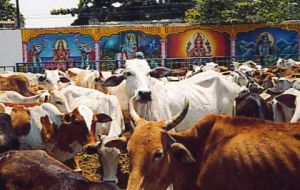MercoPress. South Atlantic News Agency
India becoming leading exporter of bovine meat: 1.66 million tons in 2012
 Despite a national cattle and buffalo herd estimate at 323.74 million, Indians per capita meat consumption is 2 kilos
Despite a national cattle and buffalo herd estimate at 323.74 million, Indians per capita meat consumption is 2 kilos Indian buffalo meat exports have grown to record levels in the last two years, making India the fourth country in the world to export more than 1 million tons of bovine meat annually.
As a result, 2013 buffalo meat exports are forecast at 2.15 million tons (on a carcass weight equivalent basis), around 30% over 1.66 million tons in 2012. Last year meat exports were revised up to a record 1.29 million tons.
India’s bovine herd continues to grow in response to strong demand for dairy products, with calendar year 2013 combined stocks forecast at 327 million head and 2012 combined stocks estimated at 323.74 million head. Indian per capita consumption remains at 2 kilograms, reflecting a preference for pulses, dairy, and poultry.
Private sector investment has led to notable improvements in dairy management practices, including extension services, veterinary care, and improved genetics. Recently, rain deficit situations in parts of India (Karnataka, Gujarat, Maharashtra, and Rajasthan) have led farmers to focus on dairying when crop production failed.
Thus, herd growth is expected to continue in the short-term, with calendar year 2013 combined stocks forecast more than 1% over 2012 at 327 million head. This year combined stocks for cattle and buffalo are estimated at 323.74 million head, and 2011 stocks have been revised upwards to 320.80 million head.
Although no official production statistics are available, industry sources and export data indicate that continued strong export demand is triggering expansion in buffalo meat supplies in India.
As a result, new slaughterhouses are emerging, providing farmers with a new market for non-productive buffalo heifers, bulls and bull calves. In 2013 Indian buffalo meat production is thus forecast to rise to a record 4.16 million tons (on a carcass weight equivalent basis), up 14% from 2012.
In 2012 buffalo meat production is estimated at 3.64 million tons (up 12% from 2011), and 2011 production has been slightly revised up to 3.24 million tons. Industry and government sources have indicated that cattle supplies will remain robust over the next decade, but will level off as more productive dairying technology is adopted and inefficient dairy producers exit the market.
Indian federal and state laws prohibit the slaughter of cattle for religious concerns. Buffalo slaughter is allowed, although it is restricted to bulls and unproductive heifers. Due to the profitability of meat production in India, farmers now have an incentive to salvage and sell buffalo bull calves which were previously unused. Given this option, some farmers are fattening calves for slaughter, although the practice is still uncommon and Indian slaughter yields remain low.
These projects are funded by the National Bank for Agricultural and Rural Development and are being launched in a bid to achieve a growth rate of 10% for the meat sector in the 11th Five Year Plan period. One of the project5s promotes rearing of buffalo bull calves for meat production and develops linkages with export-oriented slaughterhouses.
The National Dairy Development Board (NDDB), in partnership with the Government of India and the World Bank, has developed a National Dairy Plan (NDP) in order to increase productivity of dairy animals and to provide rural milk producers with greater access to the organized milk-processing sector. The first phase of the plan, NDP 1, has a financial outlay of 416 million dollars and will be carried out between 2012 and 2017.
India’s per capita buffalo meat consumption is estimated at approximately two kilograms per year. Increases in local consumption are marginal, reflecting population growth and India’s preference for vegetarian and dairy-based protein sources.
For non-vegetarian Indians, poultry, fish, and mutton are the most preferred meats. As incomes grow, meat consumption increases will likely occur primarily in the poultry segment. However, as previously stated, this increase will be overshadowed by the general preference for dairy and pulses.
India’s growing exports are the result of its low cost of production (relative to international competitors). Production costs are low due to herd growth from strong dairy demand and new incentives from slaughter facilities to salvage previously underutilized animals.
Given its tremendous export growth, India is likely to become the world’s largest beef (buffalo meat) exporter by 2013, if not sooner. Import of beef from all sources is restricted and as such imports are set at nil. As a price-based competitor, India has seen export increases in the previous two years to Middle Eastern, African and Southeast Asian countries. (Source: Global Trade Atlas)




Top Comments
Disclaimer & comment rules-

-

-

Read all commentsIndia exporting beef!!!
Oct 25th, 2012 - 03:25 am 0Uh, oh. That was Argentina's playing field.
How about soy for export?
Are the prices stable ???
dosn't look like there is much meat on them but they will probably end up in china
Oct 25th, 2012 - 09:50 am 0India and its blessed exporting.
Oct 25th, 2012 - 01:34 pm 0Commenting for this story is now closed.
If you have a Facebook account, become a fan and comment on our Facebook Page!